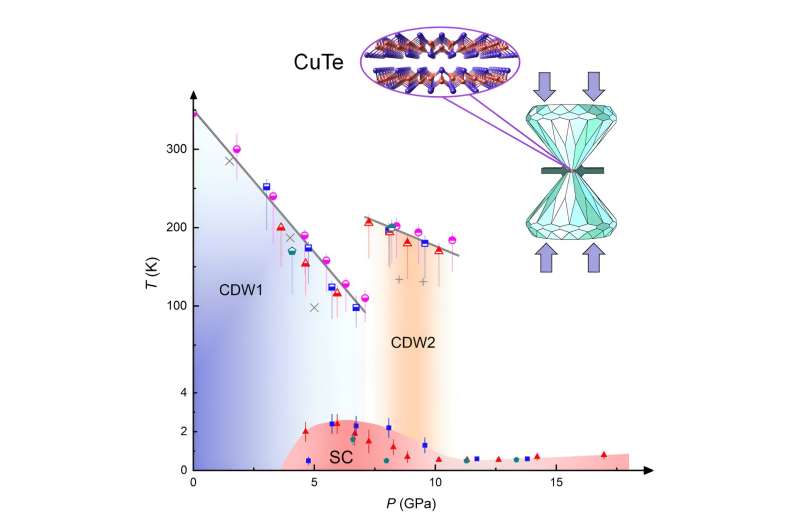This article has been reviewed according to Science X's editorial process and policies. Editors have highlighted the following attributes while ensuring the content's credibility:
fact-checked
peer-reviewed publication
trusted source
proofread
Two distinct charge density wave orders and their intricate interplay with superconductivity in pressurized CuTe

In a study published in Matter, researchers led by Prof. Yang Zhaorong and Prof. Hao Ning from the Hefei Institutes of Physical Science of the Chinese Academy of Sciences found that the quasi-one-dimensional charge density wave (CDW) material cupric telluride (CuTe) provides a rare and promising platform for the study of multiple CDW orders and superconductivity under high pressure.
The interplay between superconductivity and CDW has always been one of the central issues in the research of condensed matter physics. While theory generally predicts that they compete with each other, superconductivity and CDW can manifest complex relationships under external stimuli in practical materials. Additionally, recent research in the superconducting cuprates and the Kagome CsV3Sb5 has found that superconductivity interacts with multiple CDW orders. However, in the above two systems, there are some other quantum orders in the phase diagrams, which hinders a good understanding of the interplay between superconductivity and multiple CDWs.
In this study, the researchers provided solid evidence for a second CDW order in the quasi-one-dimensional CDW material CuTe under high pressure. In addition, they found that superconductivity can be induced and that it has complex relationships with the native and emergent CDW orders.
Based on their previous research, they used ultralow-temperature electrical transport and temperature-dependent Raman spectroscopy measurements to study the physical properties of CuTe under pressure. They found that the application of pressure can effectively suppress the original CDW order (CDW1) and induce superconductivity initially around 4 GPa. The CDW1 state underwent a transition to a new CDW state (CDW2) at about 6.5 GPa, and the transition temperature of CDW2 was significantly higher than that of CDW1.
The transition from CDW1 to CDW2 was accompanied by the appearance of a pressure-induced dome-like superconducting phase diagram, which exhibited anomalous superconducting broadening. Further theoretical calculations revealed that the CDW1 originated from the Fermi surface nesting effect, while the CDW2 was driven by the electronically correlated interaction.
"Compared with pressurized CsV3Sb5, where similar physics of superconductivity and multiple CDWs exist, CuTe with a clean and simple binary compound highlights its potential as an ideal platform to study the interplay between the superconductivity and multiple CDWs," said Wang Shuyang, a member of the team.
More information: Shuyang Wang et al, Two distinct charge density wave orders and emergent superconductivity in pressurized CuTe, Matter (2023). DOI: 10.1016/j.matt.2023.07.018
Journal information: Matter
Provided by Chinese Academy of Sciences





















